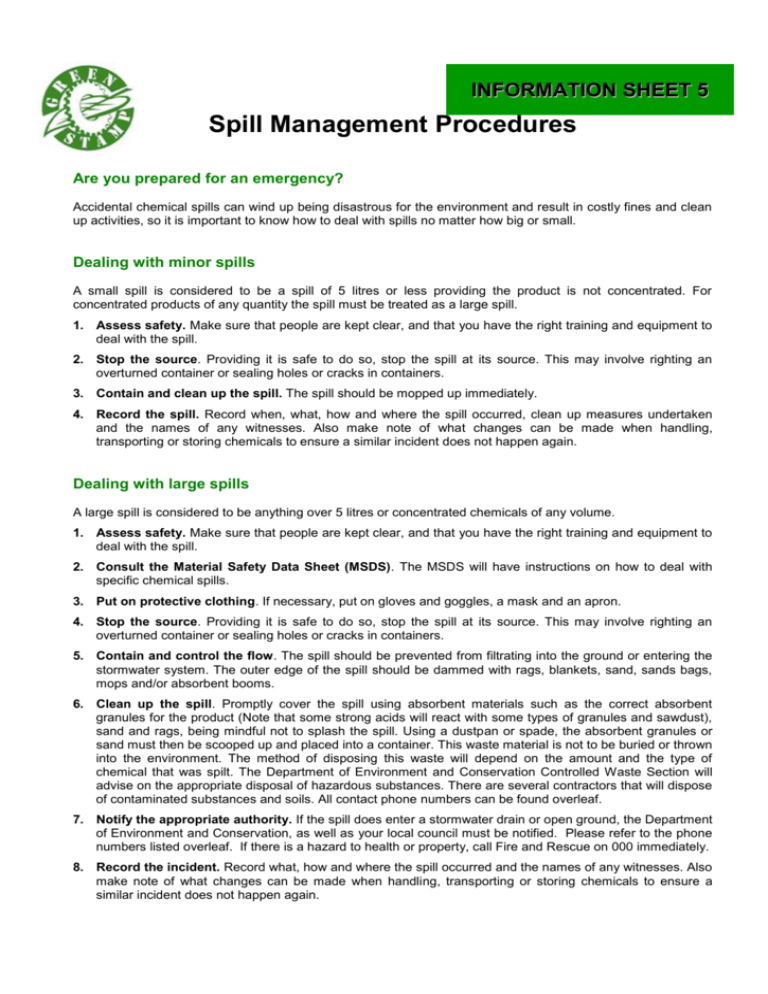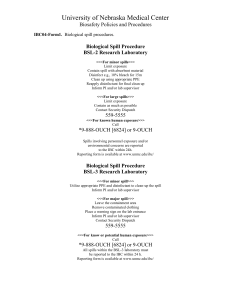Spill Management Procedures
advertisement

INFORMATION SHEET 5 Spill Management Procedures Are you prepared for an emergency? Accidental chemical spills can wind up being disastrous for the environment and result in costly fines and clean up activities, so it is important to know how to deal with spills no matter how big or small. Dealing with minor spills A small spill is considered to be a spill of 5 litres or less providing the product is not concentrated. For concentrated products of any quantity the spill must be treated as a large spill. 1. Assess safety. Make sure that people are kept clear, and that you have the right training and equipment to deal with the spill. 2. Stop the source. Providing it is safe to do so, stop the spill at its source. This may involve righting an overturned container or sealing holes or cracks in containers. 3. Contain and clean up the spill. The spill should be mopped up immediately. 4. Record the spill. Record when, what, how and where the spill occurred, clean up measures undertaken and the names of any witnesses. Also make note of what changes can be made when handling, transporting or storing chemicals to ensure a similar incident does not happen again. Dealing with large spills A large spill is considered to be anything over 5 litres or concentrated chemicals of any volume. 1. Assess safety. Make sure that people are kept clear, and that you have the right training and equipment to deal with the spill. 2. Consult the Material Safety Data Sheet (MSDS). The MSDS will have instructions on how to deal with specific chemical spills. 3. Put on protective clothing. If necessary, put on gloves and goggles, a mask and an apron. 4. Stop the source. Providing it is safe to do so, stop the spill at its source. This may involve righting an overturned container or sealing holes or cracks in containers. 5. Contain and control the flow. The spill should be prevented from filtrating into the ground or entering the stormwater system. The outer edge of the spill should be dammed with rags, blankets, sand, sands bags, mops and/or absorbent booms. 6. Clean up the spill. Promptly cover the spill using absorbent materials such as the correct absorbent granules for the product (Note that some strong acids will react with some types of granules and sawdust), sand and rags, being mindful not to splash the spill. Using a dustpan or spade, the absorbent granules or sand must then be scooped up and placed into a container. This waste material is not to be buried or thrown into the environment. The method of disposing this waste will depend on the amount and the type of chemical that was spilt. The Department of Environment and Conservation Controlled Waste Section will advise on the appropriate disposal of hazardous substances. There are several contractors that will dispose of contaminated substances and soils. All contact phone numbers can be found overleaf. 7. Notify the appropriate authority. If the spill does enter a stormwater drain or open ground, the Department of Environment and Conservation, as well as your local council must be notified. Please refer to the phone numbers listed overleaf. If there is a hazard to health or property, call Fire and Rescue on 000 immediately. 8. Record the incident. Record what, how and where the spill occurred and the names of any witnesses. Also make note of what changes can be made when handling, transporting or storing chemicals to ensure a similar incident does not happen again. Who to call in an emergency All hours phone numbers Life / property emergencies: Ambulance, Fire or Police 000 Pollution emergencies - Department of Environment and Conservation 1800 018 800 Poisons Information Centre 13 11 26 Swan River Trust (Swan and Canning Rivers only) 0419 192 845 Water Corporation – Emergencies and water service difficulties 13 13 75 Business hours phone numbers Fire and Emergency Services Authority 9323 9300 Department of Environment and Conservation 6467 5000 Department of Mineral and Petroleum Resources – Explosive and Dangerous Goods 9222 3333 Swan River Trust (Swan and Canning Rivers only) 9278 0400 Your local council …………………………………………………………………………… Who to call to for advice or removal of hazardous waste Business hours phone numbers The Department of Environment and Conservation - Controlled Waste Section 6467 5299 For spill kit suppliers refer to the Products and Services Directory or look in the Yellow Pages under ‘Oil and chemical spill recovery and dispersal’. For hazardous waste removal services refer to the Green Stamp’s Product and Service Directory or look in the Yellow Pages under ‘Waste Reduction and Disposal’. Make your own Spill Kit The components of an effective spill kit are accessible from most hardware stores or supermarkets. A good spill kit should include the following; a couple of bags of kitty litter, saw dust or sand to absorb spilt liquids brooms, dustpans and a square mouth shovel to sweep up the absorbent material absorbent pillows or booms (available from spill kit suppliers) to contain larger liquid spills and prevent spills entering drains heavy duty plastic bags or plastic drums (with a lid) to contain hazardous material prior to disposal appropriate personal protective clothing (such as chemical resistant gloves, safety glasses) a wheelie bin to contain all the above equipment and store hazardous material prior to disposal Ensure that the spill kit is clearly labelled and located in an easily accessible position for all staff. Ensure that all staff are aware of and can access the Spill Management Plan and know how to use the spill kit in case of an emergency. For further information about the Green Stamp program and how to incorporate environmental best management practices in your printing business, please contact; Green Stamp Coordinator - PIAA Tel: (08) 9361 4625 Fax: (08) 9362 5085








